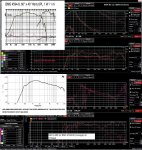Peter Morris:
Thank you very much.
It is very helpful to get some kind of consensus that your baseline is not all wrong.
I have learned that there are many ways to get a flat FR and that they all sound different. Different strategies depending on whether you go for primarily lowering peaks, or rising dips, - how much gain, - ignoring the very sharp variations or going for +-1dB. etc.
In my current EQ setting I have a +7.1dB @ 4.861Khz Q=3.6(0.4oct.) to make up for the dip on my measurement?? Some recordings can sound a bit harsh, but without the EQ, the sound is not 'right'.
- Further I have been having a hard time making the 4-12Khz area sound smooth. The hard bit for me has been determining where the problem is. I learned that even small variations in the very high frequency area can cause it. The solution for now, has been to focus on getting the HF measurement smooth and with a small rise from 5Khz. While chasing the smooth VHF - attention to mic placement in front of the horn is very important.
Jason Joseph:
Thank you very much for sharing. Resolutions on our graph is 20dB vs. 5dB on mine. Could you adjust and post again?
If you can find the time to share your DSP settings, that would be interesting also.
Discussing measurement approaches:
- Another thing is measurement-distance and off-axis measurements. What is the 'correct' distance when measuring a horn, and even a coaxial CD?
I heard someone talking about coaxial compression drivers beaming at short distances, - which can give some strange VHF artifacts.
I tried off-axis-average measurements to pursue a 'power response' like approach. Interesting work which can explain some of the mismatch between the on axis FR and your perception of the sound in a room.
Here are my current DSP settings which reflects the FR in post 501:
DSP, MH90 IIR version 10:
HF: BMS 4594nd HE 16/16 Ohm
Passive BMS crossover
Powersoft K6 DSP amp
Delay: 1.8ms
Gain: 32db
| Type | FREQ | Q | dB |
| Highpass LR24 | 702 | | |
| Peaking | 760 | 3 | +4.3 |
| Peaking | 859 | 1.6 | -1.5 |
| Peaking | 1.122 | 4.1 | -1.5 |
| Peaking | 2.870 | 4.3 | -2.7 |
| Peaking | 3.244 | 2.9 | -0.9 |
| Peaking | 4.088 | 6.9 | -2.0 |
| Peaking | 4.861 | 3.6 | +7.1 |
| High Shelving | 1.25 oct. | 7.772 | -2 |
| Peaking | 8.476 | 1.7 | +2.1 |
| Peaking | 9.863 | 14 | +2.7 |
MID:
2 x RCF MB12N351 8 Ohm.
Powersoft K8 DSP amp
Delay: 0ms
Gain: 32db
| Type | FREQ | Q | dB |
| Highpass LR24 | 100 | | |
| Lowpass LR24 | 702 | | |
| Peaking | 116 | 1.1 | +6 |
| Peaking | 364 | 3.8 | -7 |










